NASA has developed a small, lightweight nuclear reactor power system which can last for a very long time during the exploration mission on the moon, Mars and in other planets as well. Kilopower Reactor Using Stirling Technology is a fission power system which is capable of providing up to 10 kilowatts of electrical power for at least 10 years. This is enough energy to power many houses. NASA says that four KRUSTY units will provide power for the alien missions.
A KRUSTY system will be useful when setting up an outpost on the moon and areas where solar energy will be in limited quantity. The moon takes almost 28.5 days to spin around the earth, which means one lunar night is equal to a fortnight on Earth. Marc Gibson, lead Kilopower engineer at NASA Glenn Research Center said, “Kilopower gives us the ability to do much higher power missions and to explore the shadowed craters of the moon. When we start sending astronauts for long stays on the Moon and to other planets, that’s going to require a new class of power that we’ve never needed before.”
A single KRUSTY unit uses a uranium-235 reactor core which is in the size of a paper towel. The heat is then transferred through the pipelines to Stirling engines, which later converts the heat energy into electricity. A previous experiment showed that KRUSTY can create electricity to be used in a wide variety of environments. David Poston, the DOE’s chief reactor designer at the Los Alamos National Laboratory said, “We threw everything we could at this reactor, in terms of nominal and off-normal operating scenarios, and KRUSTY passed with flying colors”.
The Nevada test took place in four different stages. First two were conducted to ensure that every part was working as expected. During the third phase, the team started to increase the uranium core’s heat. The final phase of testing was done in 28 hours to check the working of an actual mission. Space is unpredictable so the scientists simulated as many failure scenarios as possible. These included unexpected power reductions, failed engines, and failed heat pipes. KRUSTY was able to stand by all of these successfully.
NASA and DOE researchers are now preparing for more rigorous tests on the reactor. There will be some more mission simulations and potential failures to consider in the tests. There is still some work remaining till Kilopower lights up the moon. Gibson said, “We put the system through its paces. We understand the reactor very well, and this test proved that the system works the way we designed it to work. No matter what environment we expose it to, the reactor performs very well.”

